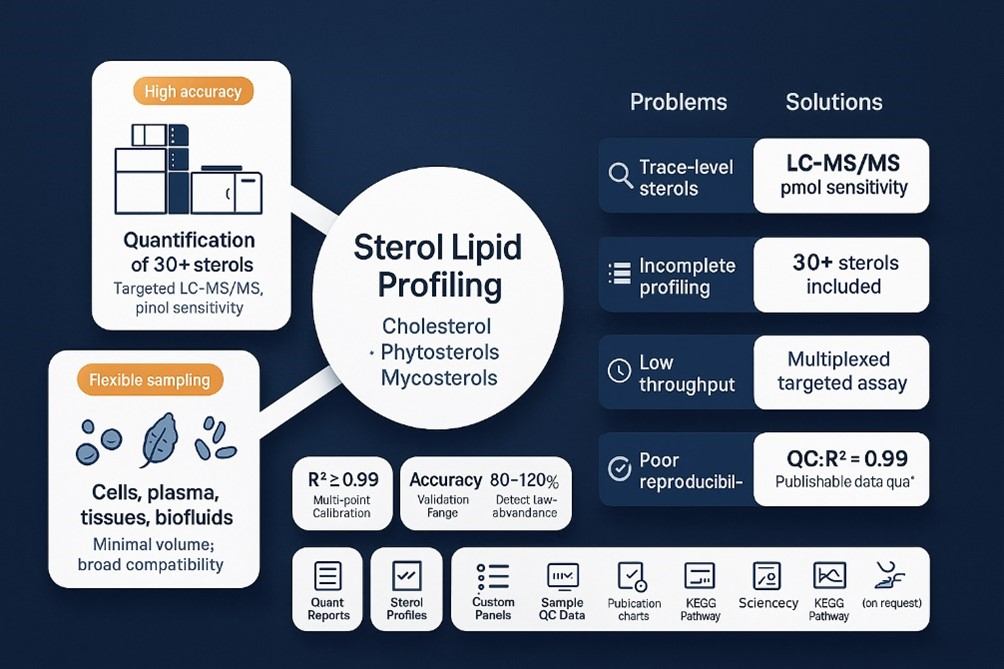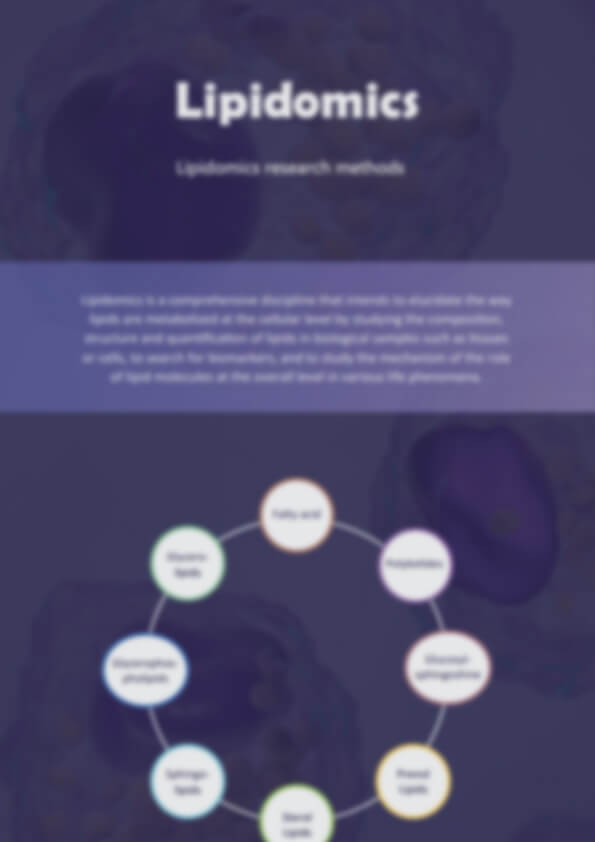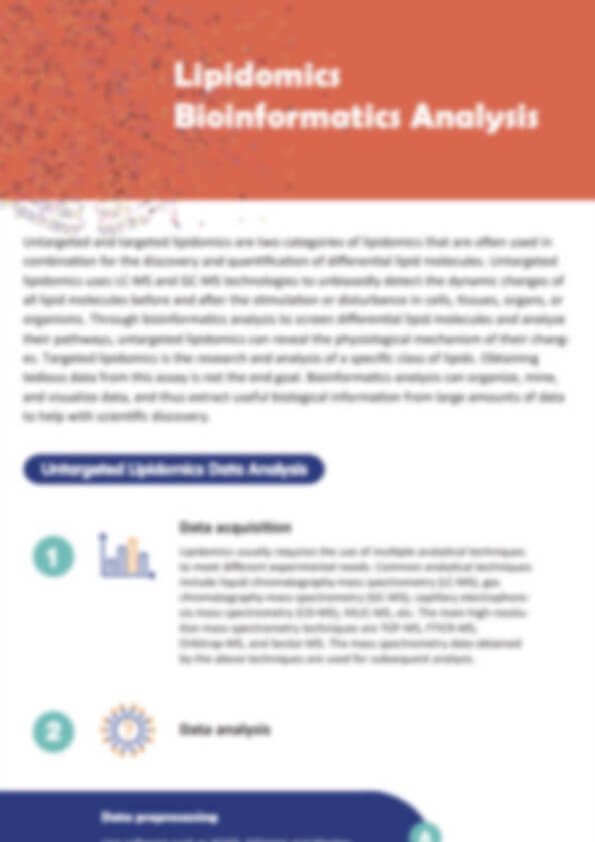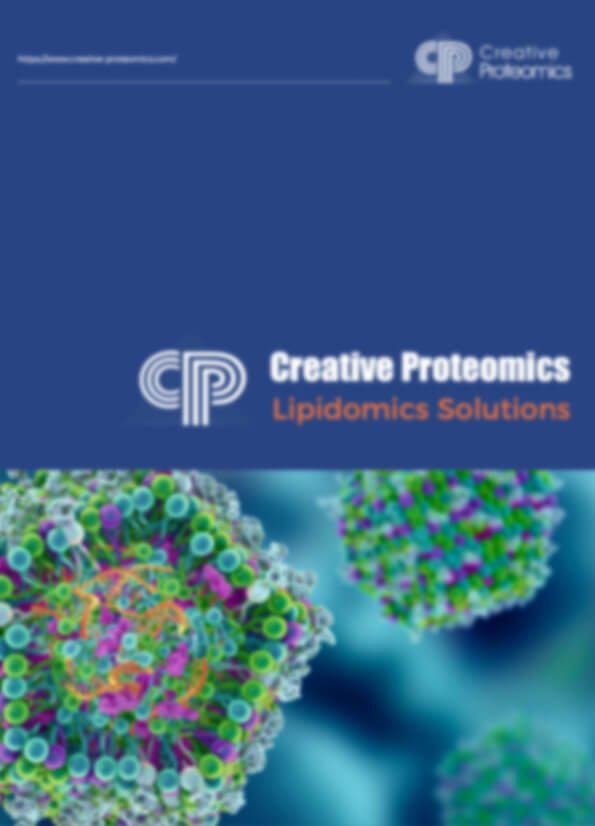Sterol Lipids Analysis Service
Sterol lipids—such as cholesterol, phytosterols, and mycosterols—play essential roles in membrane biology, hormone biosynthesis, and metabolic regulation. At Creative Proteomics, we offer targeted sterol lipid analysis using high-resolution LC-MS/MS, enabling researchers to precisely quantify sterols across a wide range of biological samples.
Why Choose Creative Proteomics
- Quantification of 30+ sterol species including cholesterol, β-sitosterol, lanosterol
- LC-MS/MS–based targeted lipidomics with pmol-level sensitivity
- Flexible sample support: cells, tissues, serum, plasma, biofluids
- Strict QC: R2 > 0.99, accuracy 80–120%
- Custom analysis for rare sterols and specialized research needs
Submit Your Request Now
×
- What We Provide
- List of Sterol Lipids
- Technology Platform
- Advantages
- Sample Requirements
- Demo
- FAQs
- Publications
What are Sterol Lipids?
Sterol lipids are a class of naturally occurring molecules that play essential roles in cellular and metabolic functions. Structurally, sterols are polycyclic hydrocarbons with a hydroxyl group attached to one of the carbon rings, which gives them amphipathic properties (both hydrophobic and hydrophilic). This unique structure allows sterols to integrate into biological membranes, where they contribute to membrane fluidity and stability.
Sterols are also precursors for a variety of bioactive molecules, including steroid hormones, bile acids, and vitamins D and K. These hormones regulate critical physiological processes such as metabolism, immune function, and reproduction. In humans, cholesterol is the most well-known sterol, serving not only as a building block for hormones like estrogen, testosterone, and cortisol, but also in the synthesis of bile acids needed for digestion.
Sterols can be categorized into three primary subclasses based on their structural differences:
- 4,4-desmethylsterols: These sterols lack a methyl group at position 4.
- 4a-methylsterols: These contain a methyl group at position 4a.
- 4,4-dimethylsterols: These sterols have two methyl groups at position 4.
Due to their complex and diverse chemical structure, sterols are found across various organisms, including animals, plants, and fungi, each contributing uniquely to the organism's metabolism. For example, in plants, phytosterols such as β-sitosterol play key roles in membrane structure and plant growth, while in animals, cholesterol is integral to cellular functions and the production of vital hormones.
What Specific Projects Does Creative Proteomics Offer?
At Creative Proteomics, we offer a specialized Sterol Lipids Analysis Service designed to support cutting-edge research in lipidomics, metabolic studies, and drug development. Our service is tailored for researchers and laboratories seeking precise and reliable quantification of sterol lipids in various biological samples.
Quantification of Sterol Lipids:
We provide high-throughput, accurate quantification of over 30 different sterol lipids from a variety of sources, including animal tissues, plant extracts, and microbial cultures. Our analysis covers common sterols such as cholesterol, phytosterols (e.g., β-sitosterol), and mycosterols.
Sterol Profiling:
Researchers can obtain a comprehensive sterol lipid profile from their samples, enabling a deeper understanding of sterol composition across different biological systems. This profiling can be used to study metabolic pathways, evaluate dietary influences on lipid metabolism, or monitor changes in sterol levels under various experimental conditions.
High-Resolution Detection:
Using advanced Liquid Chromatography Tandem Mass Spectrometry (LC-MS/MS) technology, we achieve high-resolution separation and precise quantification of sterols, even at trace levels. This approach ensures that subtle variations in sterol concentrations are accurately captured, which is essential for studies focused on lipid metabolism and disease modeling.
Custom Sterol Analysis:
In addition to standard sterol lipids, we offer customized analysis to meet specific research needs. Whether you're studying rare sterols or need to measure a particular subclass of sterols, we can tailor the analysis to suit your requirements. Our team will work closely with you to design an optimal testing strategy.
Sterol Detection from Various Sample Types:
We accept a wide range of sample types, including cultured cells, tissues, serum, plasma, and biological fluids. Our service is optimized for minimal sample volumes, making it easier to work with limited or precious samples.
Data Analysis and Reporting:
Our team provides detailed, easy-to-understand reports that include the concentrations of each sterol lipid in your samples. These reports can be integrated into your research publications or used to guide further experimental work.
List of Sterols Lipids We Can Analyze
| List of Sterol Lipids We Can Analyze | |||
|---|---|---|---|
| 19-Hydroxycholesterol | 22r-Hydroxycholesterol | 3β, 15α Cholestanol | 4,6 Chlestadiene-3-one |
| 20-Hydroxycholesterol | 24,25-Epoxycholesterol | 3β, 15β Cholestanol | 4-chol-22OH-3one |
| 24-Dihydrolanosterol | 24-Hydroxycholesterol | 3β, 15β Cholestanol | 4-chol-24OH-3one |
| 25-Hydroxycholesterol | 26-Hydroxycholesterol | 4-chol-25OH-3one | 4-chol-26(25r)OH-3one |
| 26(25r)-Hydroxycholesterol | 3,16-Dioxo Cholestenoic Acid | 4-chol-26(25s)OH-3one | 4-chol-27acid-3one |
| 3β, 15α Cholestanol | 3β, 15β Cholestanol | 5/6α Epoxycholesterol | 4-chol-2OH-3one |
| 4-chol-22OH-3one | 4β-Hydroxycholesterol | 7-Dehydrocholesterol | 7-Ketocholesterol |
| 5-chol-3-one | 7α-Hydroxycholestenone | 7α-Hydroxycholesterol | 8(14) Cholesten 3OH 15one |
| 8(14) Cholesten 3β, 15α Diol | 8(14) Cholesten 3β, 15β Diol | 8(14) Cholesten 3βOH 15one | β-Sitosterol |
| β-Sitosterol | β-Sitosterone | Cholestan 3OH 15one | Cholestanol |
| Cholesterol | Cycloartenol | Desmosterol | Dihydroxy Ketocholesterol |
| Lanosterol | Lathosterol | TriOH Cholesterol | Zymosterol |
Methods for Sterol Detection
Liquid chromatography tandem mass spectrometry (LC-MS/MS) technology is one of the commonly used metabolites detection and analysis methods. Due to its strong specificity, high sensitivity, and fast analysis speed, it is favored by mass spectrometry scholars and medical researchers.
In order to provide better service, Creative Proteomics has developed a high-throughput, high-coverage, high-sensitivity targeted quantification method for steroids. Through one analysis, the levels of multiple steroid hormones can be quantified at the same time, which can effectively save manpower and material resources, improve throughput and meet the detection requirements of most steroid hormones in the laboratory.

Agilent 1260 Infinity II (Figure from Agilent)

Thermo Fisher Scientific Q Exactive™ Plus (Figure from Thermo Fisher)
Workflow of Sterol Lipids Service

Advantages of Our Sterol Detection
- High Coverage: We analyze over 30 different sterol lipids, including common animal sterols, plant sterols, and mycosterols, ensuring comprehensive lipid profiling.
- High Sensitivity: Our analysis can detect sterol lipids at picomolar concentrations (pmol/mL), allowing for accurate quantification even in low-abundance samples.
- High Throughput: Our efficient workflow allows for the simultaneous analysis of multiple sterols in a single sample, saving time and resources.
- Strict Quality Control: We maintain stringent quality standards, with correlation coefficients (R²) for linear regression greater than 0.99 and analysis accuracy between 80% and 120%.
- Advanced Technology: Our instruments, including the Agilent 1260 Infinity II HPLC and Thermo Fisher Q Exactive™ Plus mass spectrometer, ensure precision and reliability.
- Customizable Service: We offer flexible solutions tailored to your specific research needs, including customized sterol analyses for rare or specialized compounds.
- Fast and Reliable Results: We provide rapid turnaround times and easy-to-read reports, ensuring quick integration of data into your research projects.
Sample Requirements for Sterol Lipids Analysis
| Sample Type | Minimum Sample Volume | Sample Preparation | Recommended Storage Conditions |
|---|---|---|---|
| Cultured Cells | 1 x 10⁶ cells | Cells should be collected and washed with phosphate-buffered saline (PBS). Lyse to release sterol content. | -80°C for long-term storage |
| Primary Mouse Cells (Cultured or Uncultured) | 1 x 10⁶ cells | Similar to cultured cells, harvest and wash with PBS, then lyse. | -80°C for long-term storage |
| Tissues (e.g., liver, heart, brain) | 50-100 mg | Tissue should be homogenized in appropriate buffer, followed by lipid extraction. | -80°C for long-term storage |
| Serum/Plasma | 200 µL | Centrifuge at 3000 RPM for 10 minutes to separate serum/plasma. No anticoagulants. | -80°C for long-term storage |
| Biological Fluids (e.g., urine, bile) | 500 µL | Collect and centrifuge to remove particulates. | -80°C for long-term storage |
| Macrophage Cells (Thioglycolate-Elicited) | 1 x 10⁶ cells | Harvest cells after thioglycolate injection. Process and lyse similarly to cultured cells. | -80°C for long-term storage |
Applications of Sterol Lipids
Lipidomics & Metabolomics
Profiling sterol compositions and metabolic pathways across biological systems.
Sterol & Lipid Metabolism
Investigating sterol roles in cellular functions, membrane structure, and metabolic disorders.
Drug Development
Assessing the impact of drugs on sterol metabolism and lipid biosynthesis.
Plant & Fungal Research
Studying phytosterols and mycosterols in plant growth, stress response, and metabolism.
Nutrition Studies
Quantifying plant sterols in foods and supplements to explore health effects, especially on cholesterol.
Endocrine Research
Exploring the role of sterols in steroid hormone synthesis and hormonal balance.
Toxicology & Environmental Studies
Investigating how pollutants affect sterol metabolism in organisms.
Microbial & Fungal Biology
Understanding sterol metabolism in microbes and fungi for potential therapeutic targets.
Demo Result of Targeted Metabolomics Service
Figures come from (Li, Y.et.al, Sci Rep,2023)
FAQ of Sterol Lipids Analysis
How long does it take to get results?
The typical turnaround time for sterol lipid analysis is 2-4 weeks from the receipt of your samples. However, for larger or customized batches, the timeline may vary. We can provide an estimated timeline once we receive your samples and specific requirements.
What is the minimum quantity of sterol lipids detectable in my sample?
Our LC-MS/MS-based platform is highly sensitive, capable of detecting sterols at concentrations as low as picomolar levels (pmol/mL). This sensitivity ensures accurate results, even for trace amounts of sterol lipids in your samples.
Can you analyze rare or less common sterols?
Yes, we can customize the analysis to target rare or specific sterol lipids, including plant sterols, fungal sterols, and other less common sterol derivatives. Please contact us with the specific sterols you're interested in, and we will tailor the analysis accordingly.
Can I use your sterol analysis for comparative studies?
Absolutely! Our service is ideal for comparing sterol lipid profiles across different samples, such as various tissues, treatment groups, or experimental conditions. This can help identify biomarkers, metabolic shifts, or the effects of diet, drugs, or environmental factors.
Is your service suitable for large-scale or high-throughput studies?
Yes, our high-throughput platform is capable of processing large numbers of samples simultaneously, making it ideal for large-scale studies. Whether you're working with a few samples or hundreds, we can accommodate your needs and provide efficient, accurate results.
How do I place an order for sterol analysis?
To place an order, simply contact our customer support team or use our online submission portal. We will guide you through the submission process, including sample preparation, shipping instructions, and service customization.
Learn about other Q&A.
Sterol Lipids Analysis Case Study
Publications
Here are some publications in Lipidomics research from our clients:

- Annexin A2 modulates phospholipid membrane composition upstream of Arp2 to control angiogenic sprout initiation. 2023. https://doi.org/10.1096/fj.202201088R
- B cell-intrinsic epigenetic modulation of antibody responses by dietary fiber-derived short-chain fatty acids. 2020. https://doi.org/10.1038/s41467-019-13603-6
- Loss of G0/G1 switch gene 2 (G0S2) promotes disease progression and drug resistance in chronic myeloid leukaemia (CML) by disrupting glycerophospholipid metabolism. 2022. https://doi.org/10.1002/ctm2.1146
- Characterization of Dnajc12 knockout mice, a model of hypodopaminergia. 2024. https://doi.org/10.1101/2024.07.06.602343
- The olfactory receptor Olfr78 promotes differentiation of enterochromaffin cells in the mouse colon. 2024. https://doi.org/10.1038/s44319-023-00013-5















